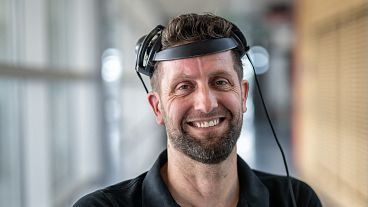Brain-computer interface technology is a fast-growing field but how does it feel to live with an implant inside of you?
In 2014, Ian Burkhart looked down at his hand and imagined closing it. To his astonishment, his hand did just that.
This was the first time a paraplegic person had regained the ability to move his arm by the sheer force of his thought, assisted by an implant in his brain.
"That was the magic moment. It proved that it was possible, it wasn't science fiction," said Burkhart, a former volunteer on an experimental brain-computer interface trial.
This fast-growing field, dominated by companies such as Synchron and Elon Musk's Neuralink, aims to use cerebral implants and algorithms to restore lost mobility and communication skills or treat neurological disorders, such as epilepsy.
But living with a brain implant is a unique experience.
Being quadriplegic and playing Guitar Hero
After a diving accident in 2010, Burkhart was paralysed from the shoulders down.
"At the age of 19, it was very difficult to hear," he told AFP via videoconference from his home in Ohio in the US.
When he heard that an American non-profit company, Battelle, was looking for volunteers for a trial to restore hand movement, he jumped on it.
He was implanted with a device the size of a pea, containing around 100 electrodes, near the motor cortex, the area of the brain that controls movement.
The device recorded his brain activity and transmitted it to a computer, which used an algorithm to decipher the exact way he wanted to move his hand. The message was then transmitted to a sleeve of electrodes placed on his right forearm, which stimulated the muscles concerned.
Burkhart became skilled enough with his hand that he was able to play guitar solos via the video game Guitar Hero.
However, funding for the trial dried up after seven and a half years, and the implant was withdrawn in 2021.
"It was a really sad time," said Burkhart, now 32.
The shock was lessened by the fact that he had only been able to use the technology in the laboratory for a few hours a week.
His scalp had become infected. "The scalp is constantly trying to close itself up, but it can't because there's a piece of metal" sticking out.
Despite this, Burkhart remains positive about his experience and defends brain-computer interfaces. He believes that fear of them is unfounded, but advocates taking greater account of patients' experiences.
‘A weird robot inside of me’
Hannah Galvin is less enthusiastic about her experience.
At 22, she saw her dreams of a career in ballet dashed by crippling epilepsy. She then benefited from an experimental implant.
"I would have done anything. I saw this as an opportunity to get my life back," Galvin, now 35, told AFP from Tasmania in Australia.
An electroencephalogram, which records electrical activity, was implanted in her brain as part of a trial conducted by the American company NeuroVista.
The idea was that the device would alert her if a seizure was imminent. But once implanted, the device kept going off, leading the young woman to think that it was malfunctioning.
This was not the case.
It turned out that Galvin was having more than 100 seizures a day. Neither she nor her doctors knew they were so frequent.
She felt embarrassed in public by the constant flashing and beeping of the device. She increasingly had the impression that "there was someone in her head and it wasn't her".
"It was a weird robot inside me, and I really wanted to rip it out of my head,” she said.
Removing the implant gave her immense relief. However, her self-confidence was damaged to the point where she no longer wanted to leave her house and had to take antidepressants.
Although it took her years to accept that her convulsions would prevent her from working, Hannah Galvin now claims to lead "a happy life", painting and photographing.
She advises patients considering a brain implant to "be more wary" than she was.



